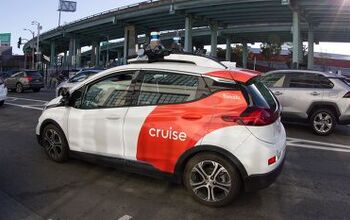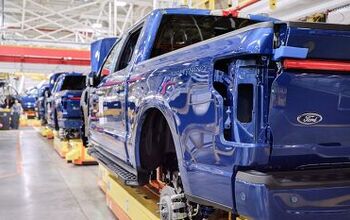Europe Now Requires Speed Regulators for All New Vehicles

On July 6th, the European Union formally introduced laws that require auto manufacturers to install speed-limiting hardware on new vehicles. While speed governors have been around for years (and are becoming increasingly popular among certain manufacturers) the EU’s new rules actually require technology that takes things a step further by allowing cars to actively detect and then regulate the speed for any given road.
Having spent the last week isolated in the wilderness, your author has been blissfully unaware of any recent regulatory actions affecting the automotive sector with one exception. During one of the few moments where I had both access to electricity and 4G cell service, I noticed a slew of soul-crushing news alerts about how the European Commission had just mandated “Intelligent Speed Assistance” (ISA) systems on all new models. That makes this story a little dusty, though no less pertinent to readers who like to use their vehicle as more than a conveyance or value their privacy from behind the wheel.
As the law currently stands, there’s no specific way a manufacturer has to implement the system. While the device is required to warn the driver and/or automatically slow down the vehicle when they surpass the posted speed limit, there is no rule saying ISA has to be on. Cars only need to have the system equipped — leaving the manufacturer the decide whether it should be permanently active or not.
Regulators don’t seem to care how it’s done, just that all new models come with the capability by default. But there are a few additional items accompanying the new rules that deepen the rabbit hole. ISA systems are also required to monitor the posted limits using exterior vehicle camera systems and the EU wants to leverage “deep learning” to create a comprehensive speed-limit map to be shared between all automobiles. With privacy concerns already at the forefront of many consumers’ minds, one can see why a government-backed program to collect data from literally every vehicle on the road might not be well received. There’s already been a lot of criticism over the European Commission wanting to centralize traffic enforcement in a manner reminiscent of Chinese-style data hubs and this feels like the continent is taking another big step in that direction.
The European Road and Safety Charter makes it pretty clear that ISA systems regulating speed will be able to be overridden by drivers right now. However, there are obvious concerns that that won’t always be the case, especially since systems can be tweaked by over-the-air updates issued by manufacturers. It’s not a stretch to imagine the laws changing in a few years and the government mandating that active ISA become obligatory under certain circumstances. In fact, it might actually be more dangerous to use the system until all mapping has been completed and the systems have better accuracy at predicting posted speed limits — further encouraging regulators to wait on the more invasive modes of implementation.
Presently, the EU will only require entirely new vehicle models to have ISA installed. But things change in July 2024, when the rule is extended to every freshly manufactured automobile regardless of how old the design happens to be.
The European Commission feels confident the move will help curtain accidents, saying that excessive speed contributes to around 30 percent of fatal crashes in the EU. The concept has actually been around for almost two decades, though it wasn’t until recently that vehicle tech reached a point where it could be implemented on a large scale. The government even had previously suggested implementing ISA along with vehicle interlock systems designed to prevent drunk driving and lowing the speed limit by 1 kph — which it claimed would reduce fatal crashes by 5 percent. That assertion came by way of a larger study that roped in data from several European nations to determine whether ISA would be effective.
From the European Commission:
The EU-funded and [Society for Risk Analysis] co-ordinated [sic] project PROSPER looked into ways that advanced assisted driving technology and technology relating to speed limitation devices can improve safety, and also at the barriers for the implementation of ISA. The PROSPER project calculated crash reductions for six countries. Reductions in fatalities between 19-28 [percent], depending on the country, were predicted in a market-driven scenario. Even higher reductions were predicted for a regulated scenario — between 26-50 [percent]. Benefits are generally larger on urban roads and are also larger if more intervening forms of ISA are applied. Trials with ISA have been carried out in ten European countries: Austria, Belgium, Denmark, Finland, France, Hungary, The Netherlands, Spain and Sweden. An earlier study in the Netherlands showed that ISA could reduce the number of hospital admissions by 15 [percent] and the number of deaths by 21 [percent]. Research has shown that ISA and physical measures to reduce road speed are complementary rather than competing methods.
The “market-driven scenario” indicates manufacturers implementing ISA on their own, while the “regulated scenario” indicates the government forcing the issue. Though we don’t seem to have a clear case of either, as the European Commission is effectively forcing manufacturers to implement ISA while not yet technically requiring drivers to use it.
[Image: Nikola Barbutov/Shutterstock]

A staunch consumer advocate tracking industry trends and regulation. Before joining TTAC, Matt spent a decade working for marketing and research firms based in NYC. Clients included several of the world’s largest automakers, global tire brands, and aftermarket part suppliers. Dissatisfied with the corporate world and resentful of having to wear suits everyday, he pivoted to writing about cars. Since then, that man has become an ardent supporter of the right-to-repair movement, been interviewed on the auto industry by national radio broadcasts, driven more rental cars than anyone ever should, participated in amateur rallying events, and received the requisite minimum training as sanctioned by the SCCA. Handy with a wrench, Matt grew up surrounded by Detroit auto workers and managed to get a pizza delivery job before he was legally eligible. He later found himself driving box trucks through Manhattan, guaranteeing future sympathy for actual truckers. He continues to conduct research pertaining to the automotive sector as an independent contractor and has since moved back to his native Michigan, closer to where the cars are born. A contrarian, Matt claims to prefer understeer — stating that front and all-wheel drive vehicles cater best to his driving style.
More by Matt Posky
Latest Car Reviews
Read moreLatest Product Reviews
Read moreRecent Comments
- THX1136 What happened to the other companies that were going to build charging stations? Maybe I'm not remembering clearly OR maybe the money the government gave them hasn't been applied to building some at this point. Sincere question/no snark.
- VoGhost ChatGPT, Review the following article from Automotive News: and create an 800 word essay summarizing the content. Then re-write the essay from the perspective of an ExxonMobil public relations executive looking to encourage the use of petroleum. Ensure the essay has biases that reinforce the views of my audience of elderly white Trump-loving Americans with minimal education. Then write a headline for the essay that will anger this audience and encourage them to read the article and add their own thoughts in the comments. Then use the publish routine to publish the essay under “news blog” using Matt Posky listing the author to completely subvert the purpose of The Truth About Cars.
- VoGhost Your source is a Posky editorial? Yikes.
- Fed65767768 Nice find. Had one in the early-80s; loved it but rust got to it big time.Still can't wrap my head around $22.5K for this with 106,000 km and sundry issues.Reluctant (but easy) CP.
- El scotto err not be an EV but to own an EV; too much training this week along the likes of what kind of tree would be if you were a tree? Sorry. Bring back the edit function.


































Comments
Join the conversation
More links about speed limiters https://www.torquenews.com/106/one-simple-reason-why-ram-trx-only-goes-118 https://www.ramrebel.org/threads/how-to-disable-the-speed-limiter.62872/ Matt I think to be fair and objective you need to mention that most vehicles have speed limiters and why they have them. You should have also done more research on speed limiters and whether you agree with putting them on vehicles or not and why manufacturers put them on. Do you really want to drive a high profile vehicle like a Ram Rebel or Jeep more than 118 mph? A Corvette or a lower profile vehicle is more stable at higher speeds than a pickup or suv. Additionally Matt we the readers would like to know what the actual top speed the Europeans are proposing to limit. If it is 155 mph then Mercedes and BMW already have that. As for putting in a speed regulator that regulates a specific speed for a specific area or posted speed limit we the readers would like to know if the technology exists now. Speed limiters on vehicles themselves have existed for decades but limiting to a specific speed limit is something I have not heard of before. More information would be greatly appreciated.
The way it's written, this isn't as big a deal as it sounds. Many of the manufacturers already offer systems that meet the requirements. Taking BMW for instance, their European models normally have a "LIM" button on the steering wheel by the cruise control buttons that provides this functionality. It'll read speed limit signs, and stop your acceleration when you hit the limit (or a configurable amount over the limit). If you press hard enough on the accelerator (or push the button to turn the feature off), it'll let you go past it. To be honest, it's a really useful feature for day to day driving so that you don't have to watch your own speed as closely.